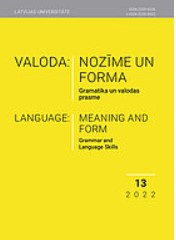Lithuanian and Latvian laterals: Comparison of acoustic properties
Lithuanian and Latvian laterals: Comparison of acoustic properties
Author(s): Jolita Urbanavičienė, Jana TaperteSubject(s): Comparative Linguistics, Baltic Languages
Published by: Latvijas Universitātes Akadēmiskais apgāds
Keywords: Lithuanian language; Latvian language; laterals; acoustic features; palatalization; formants; locus equations;
Summary/Abstract: The aim of the paper is to examine how acoustic contrast manifests itself between /l/ and /ʎ/ in Latvian, as well as /l/ and /lʲ/ in Lithuanian. For the study, speech recordings of 6 adult informants (3 Lithuanian and 3 Latvian male speakers) have been analysed. Initial and final laterals in closed symmetric [l]V[l] sequences and intervocalic syllable-initial laterals in V[l]V sequences have been examined. During the analysis, the focus is placed mainly on locus equations, as well as changes in formant structure (especially F1 and F2) triggered by position and vocalic context. Acoustic data demonstrates differences in coarticulation effects between Latvian palatal /ʎ/ and Lithuanian palatalized /lʲ/. The formant structure of /ʎ/ and /lʲ/, unlike the corresponding non-palatal laterals, is more stable and less dependent on the quality of adjacent vowels. Vowel context affects the degree of palatalization, e. g. palatalized [lʲ] next to [ɪ], [iː] and [eː] is pronounced “softer” than next to [ɔ̟], [o̟ː], [ʊ̟], and [u̟ː]. Latvian /ʎ/ is characterized by a more stable vowel F2 locus, which indicates higher degree of coarticulatory resistance to vowel effects; the quality of /lʲ/, on the contrary, depends more on vowel context. The same is true (although to lesser degree) for the Lithuanian /l/. The assumption about the similarity of Latvian non-palatal /l/ and Lithuanian palatalized /lʲ/ is only partly supported by the recent data. In terms of the degree of coarticulation (indicated by slope values of locus equations), Latvian /l/ is closer to Lithuanian /lʲ/, while its formant structure, especially low F2, brings it closer to Lithuanian /l/.
Journal: Valoda: nozīme un forma
- Issue Year: 2022
- Issue No: 13
- Page Range: 208-224
- Page Count: 17
- Language: English

